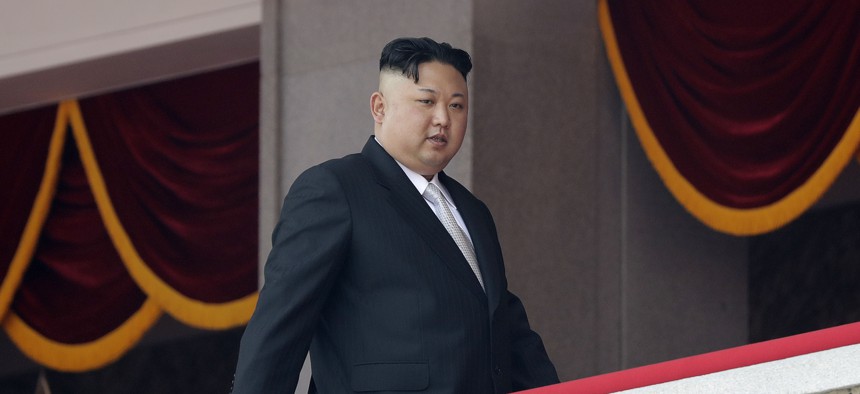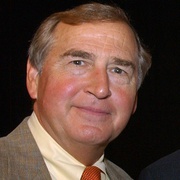
North Korean leader Kim Jong Un walks along his viewing balcony during a military parade on Saturday, April 15, 2017, in Pyongyang, North Korea. Wong Maye-E/AP
The North Korean Threat Beyond ICBMs
Even without them, the Kim regime can menace its immediate neighborhood—or sell nuclear material to rogue states.
From the moment that President Barack Obama told President-elect Donald Trump during the transition about the impending threat of North Korean nuclear-tipped ICBMs, Trump’s basic stance has been: not on my watch. From his tweet of January 2 (“won’t happen!”) to his August statements that the U.S. military is “locked and loaded” to unleash “fire and fury” on North Korea if it threatens America, Trump has sought to draw a red line that makes it clear he will do whatever is necessary to halt North Korea’s nuclear and missile programs— before they can target the continental United States.
This, of course, would pose a huge, possibly intolerable threat. Once North Korea achieved the ability to strike San Francisco or Los Angeles, it would undoubtedly continue extending its reach to the rest of the United States. At that point, Americans would have to try to live with a formidable nuclear power that, like Russia or China, could kill tens of millions in the event of all-out war. And while the United States would build up missile defenses in the hope of limiting damage and bolster its nuclear deterrent, allowing such a regime to acquire such a capability will strike most Americans as unacceptable—if there is any other realistic alternative.
But to properly assess the nuclear threat posed by North Korea, Americans must first recognize the danger that its current arsenal of up to 60 nuclear weapons already poses to the United States and its allies. Kim Jong Un can already deliver a nuclear warhead against South Korea, where nearly 28,500 U.S. servicemen are based and nearly 200,000 U.S. citizens live ; it can already hit Japan with a nuclear warhead, where close to 90,000 Americans live , including 39,000 U.S. troops. On Monday, alarm bells sounded in Japan when a North Korean missile overflew its northern provinces.
ICBMs, of course, have one fatal flaw: They leave an unambiguous return address. Kim Jong Un knows that within minutes of any launch of an ICBM against the United States, he and his regime will be toast. As Colin Powell once put it, the U.S. response would turn that country into a “charcoal briquette.”
However, there is another, even more likely way that a North Korean nuclear weapon could explode in a U.S. city: Kim could sell one to terrorists. Are the terrorists the United States is fighting today interested in nuclear weapons? Ayman al-Zawahiri, the current leader of al Qaeda, has been seeking nuclear weapons for more than a decade. Moreover, in 2016, an ISIS-related group was discovered actively pursuing nuclear materials at a Belgian nuclear power plant. Does Kim imagine he could get away with selling a nuclear weapon, or the material to make one, to a terrorist group? One would think not—and the United States must do everything possible to make him believe that.
But no one can erase the fact that Pyongyang has already crossed that line without suffering serious consequences. Beginning in 2001, North Korea sold materials, designs, and expertise to Syria that helped it build a plutonium-producing nuclear reactor. By now, that reactor would have produced enough plutonium for several nuclear bombs—had it not been destroyed by an Israeli airstrike in 2007.
What price did North Korea pay? Pyongyang got its money; Syria was bombed; and the United States was soon back at the negotiating table in the six-party talks trying, unsuccessfully, to get North Korea to give up its nuclear weapons. North Korea is known in intelligence circles as “Missiles ‘R’ Us,” having sold and delivered missiles to Iran, Syria, Pakistan, and others. As former secretary of defense Robert Gates said , the North Koreans will “sell anything they have to anybody who has the cash to buy it.” Perversely, as the United States pushes for tighter enforcement of UN sanctions on North Korea, the cash-strapped regime has greater incentives to turn back to the nuclear black market.
To address the ICBM threat in the narrow window before Kim develops an operational capability, the Trump administration has expressed a readiness to negotiate on the condition that North Korea freezes nuclear and missile tests. Such a freeze would be a significant improvement over North Korea’s relentless nuclear advance. But even if the Trump administration succeeds in stopping Kim at this point, the United Stateswill then be left with all the dangers posed by Kim’sexisting nuclear stockpile. In addition, North Korea has facilities currently producing both plutonium and highly enriched uranium, which experts estimate can produce enough fissile material for 12 additional weapons per year. So the United Statesshould also seek a freeze of North Korea’s production of fissile materials.
In addition to the current effort, Trump needs to send Kim a clear message, with an identical copy delivered to China’s president Xi Jinping: If any nuclear bomb of North Korean origin were to explode on American soil or that of an American ally, the United States will respond as though North Korea itself had hit the United States with a nuclear-tipped ICBM.
The recent “war of words” between Trump and Kim has awakened many Americans to the North Korean nuclear threat. While Americans can hope that the current confrontation will succeed in stopping further ICBM and nuclear tests, even if this succeeds, the United States will be left trying to live with the clear and present danger posed by a nuclear North Korea.
Related Video




